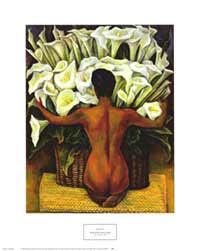|
The lily was dedicated to the goddess Hera, the wife of Zeus. Legend has it that when Zeus fathered Hercules with the mortal woman Alceme, he wished his son to partake more fully of divinity so he had the baby brought to Hera after he drugged her to sleep. The baby was placed at her breast and Hercules nursed. When Hera awoke in horrified surprise and flung the baby from her, some of her milk gushed across the heavens and formed the Milky Way. A few drops fell to earth and from those drops sprang the first lilies. Roman legend has it that when Venus rose from the sea-foam she saw a lily and she became filled with jealous envy at the whiteness and beauty of it. Seeing it as a rival to her own beauty she caused a huge and monstrous pistil to spring from the lily's snow-white center. This myth accounts for the lily being associated with Venus and the Satyrs who are the personification of lustful ardor. Early representations of the lily were discovered in a villa in Amnisos, Crete, which dates from the Minoan Period, about 1580 B.C. The lily was the Minoan sacred flower, a special attribute of the Great Minoan Goddess Britomartis or Dictynna who had her origin in Neolithic times. She maintained her supremacy in Crete until the mysterious cataclysm that befell Minoan civilization in the middle of the sixteenth century B.C. when her cult was gradually assimilated into the religion of the Greeks and she became the precursor of Greek Artemis. |
| |
